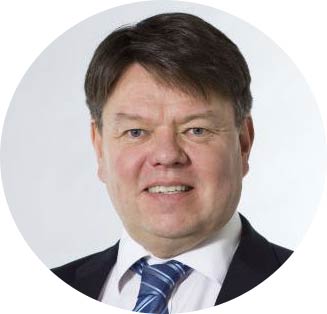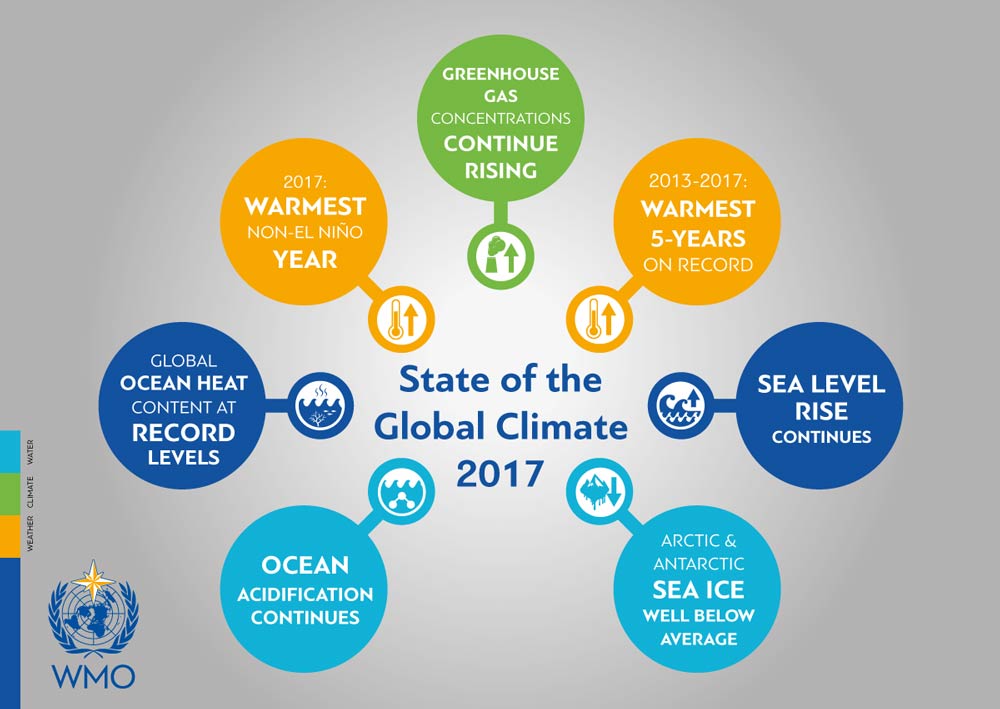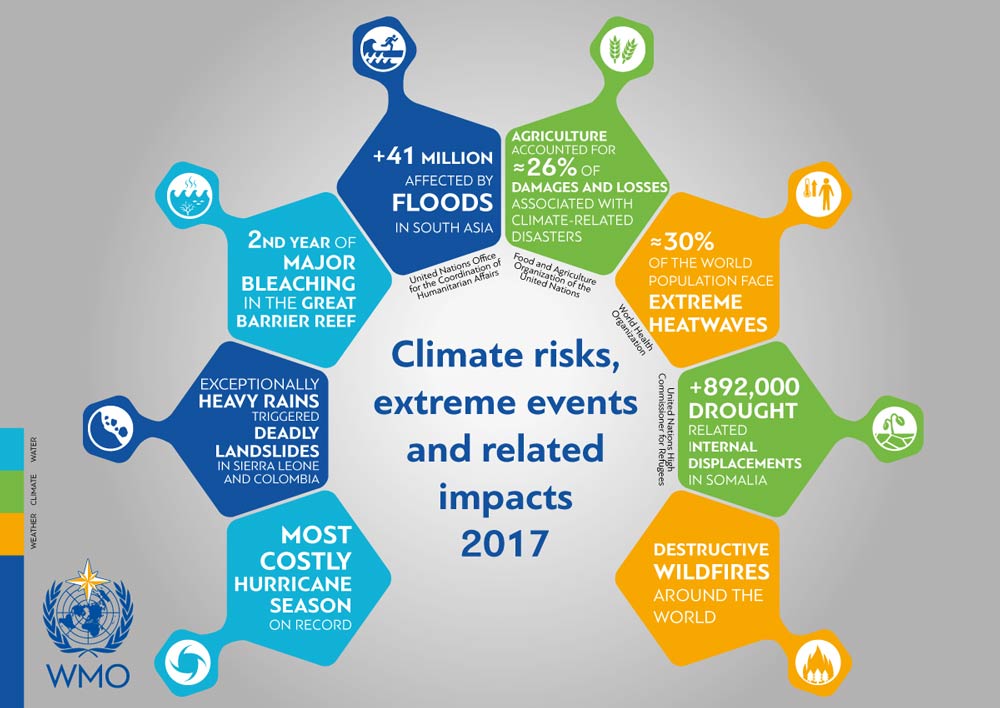
The crossover of food and fashion is becoming increasingly common, with bio-based textiles gaining entrée into the new realm of sustainable fa

The crossover of food and fashion is becoming increasingly common, with bio-based textiles gaining entrée into the new realm of sustainable fa
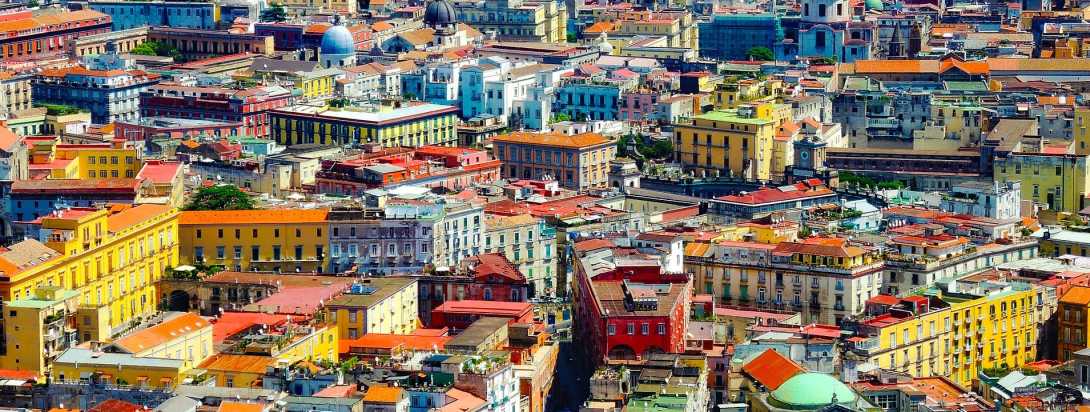
On December 2-5, Naples, Italy will host the “COP of the Mediterranean,” an international climate event focused on safeguarding the environmental richness of the Mediterrean Sea. This conference of the parties to the Barcelona Convention will bring together climate leaders from across the region for a much-needed discussion of how best to preserve the Sea’s bountiful resources and diverse wildlife.
Italy’s Minister of the Environment, Land and Sea Sergio Costa has noted that “in addition to being the sea with the most consistent trade in the world,” the Mediterranean “is also a hotbed of important biodiversity.” Costa especially looks forward to engaging the youth of Naples—a city that has for centuries thrived on the Sea’s banks—with events tied to the conference. A firm believer in the power of youth to make a difference, Costa refers to them as “the educators of the adults.”
Connect4Climate is proud to be attending the conference and supporting the outreach around it through several key events including a beach cleanup workshop and showcases of environmental music and art. Our team can’t wait to connect with climate-conscious youth and get them involved in the push for a sustainable future!
For a full rundown of the exciting activities we’ve got planned, check out the program below. You can also follow us on Twitter and Instagram and join the conversation online with the hashtags #COP21Napoli, #BarcelonaConvention, #SaveTheMediterranean, #WeAreAction, and #IoSonoAmbiente!
Images courtesy of the COP21-Naples offical website.
C4C Events Program
Monday 2 December, 9.00 am-1.00 pm
Morning beach cleanup workshop and restoration of the coastal area of San Giovanni a Teduccio in collaboration with local NGO ‘Let's Do It! Italy.’
About 150 students from local schools will be trained in advance and will work together to clean the beach. This activity will be accompanied by the installation of new benches and by the repair of beachside showers.
The restoration of the area will include the creative recycling of beach trash into musical instruments. Led by Maurizio Capone of the eco-minded band Capone & BungtBangt, youngsters will learn to fashion instruments from the rubbish and make music with them, transforming something ugly into something beautiful.
Tuesday 3 December, 7.00 pm-11.00 pm
Music for the sea: An eventful evening of music and climate positivity.
Subsonica singer-songwriter and Italian X Factor judge Samuel Umberto Romano, known for his commitment to protecting the natural world, will join forces with the artists of Napoli Segreta to DJ a night of music that will empower fans to take meaningful climate action. Topical videos will be screened throughout the event, including the premiere of the footage captured at the beach cleanup in San Giovanni a Teduccio as well as video profiles of Neapolitan youth activists and a selection of other content on the importance of safeguarding the Mediterranean.
Throughout the event, participants will be able to create personalized t-shirts with screen-printed images inspired by the theme of the sea. Equipped with a mobile printing unit, a small booth will be set up for the sustainable printing of the shirts. Guests will have the opportunity to choose a color scheme and one of two available graphics for their organic cotton shirts and print them in real time with the guidance of onsite staff.
Wednesday 4 December, 5.30 pm-7.30 pm
Climate engagement through theatre: In Naples’s eastern suburbs, an abandoned space became a theater for the community: the NEST. On the evening of December 4th, the NEST’s stage will be animated by a performance of “Fuoco Fatuo”—a story filled with music, dance and magic and rich with environmental symbolism— followed by a theatrical monologue from actor Adriano Papaleo.
Photographs by SubScatti will be presented by Fondali Campania in an installation outside the theater, and throughout the event, young talents from the Metropolitan Poetry Association will recite topical poems for the public.
[video:https://youtu.be/UypAIZqj5G8]
Banner image courtesy of Pixabay.
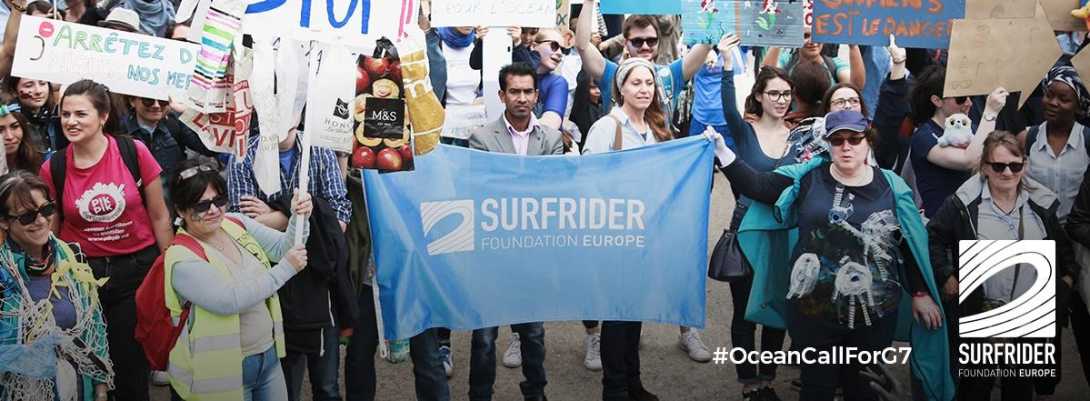
Each year, the G7 summit brings international leaders together to discuss world affairs and identify potential solutions to pressing global issues.
Women leaders take center stage in a sweeping virtual conference
For many countries around the world, the benchmarks put in place in the Paris Agreement—intended to keep net global warming to 1.5 degrees Celsius and certainly below 2 degrees—have fallen by the wayside in the years since, kicked under the rug amid the continual thrum of politics and bureaucracy. For the Marshall Islands and other low-lying nations, however, sidelining the Paris commitments is simply not an option: achieving them could be the difference between life and death.
The people and government of the Marshall Islands have become known for their unflinching 1.5 to Stay Alive climate campaign, which stresses that if temperature change surpasses 1.5 degrees, let alone 2, rising sea levels would submerge much of their ancestral and current homeland and render their beautiful nation uninhabitable. Given the Marshalls’ cultural emphasis on home, legacy, and the bounties of nature, this loss would be especially dire.
The Marshall Islands sit at the helm of a group of similarly threatened countries known collectively as the Climate Vulnerable Forum, or CVF, which aims to unite disparate voices from smaller countries and amplify their concerns for the rest of the world to hear. The group is proactive its own right too, intent on leading by example on the world stage through pioneering sustainability campaigns. Today and tomorrow, the CVF is conducting an ambitious web-based conference called the Virtual Climate Summit in a push to raise awareness of the severity of warming trends and brainstorm next steps in the ongoing battle against climate change.
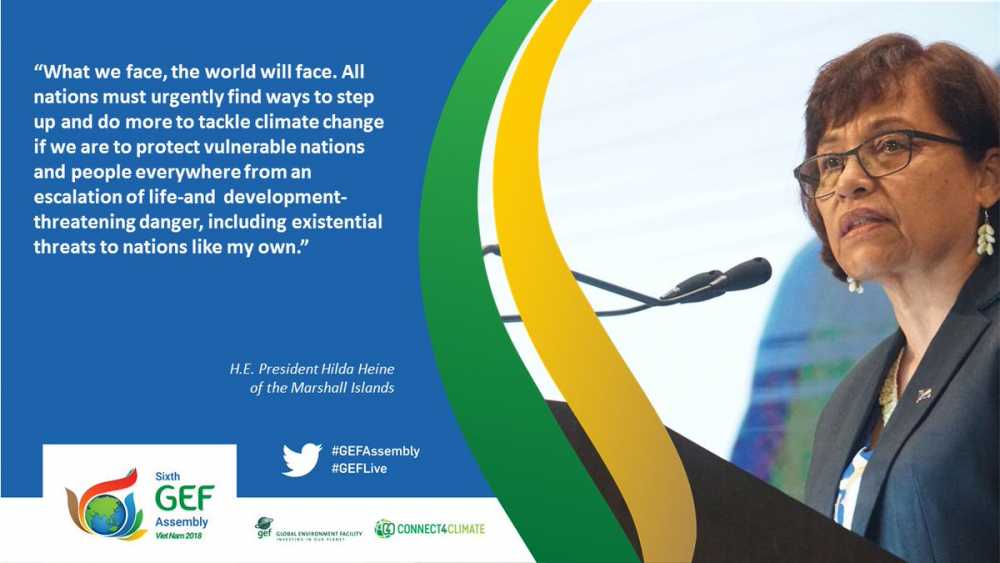
Participants in the discussion will include other imperiled island nations such as Tuvalu, Vanuatu, Timor-Leste, Sri Lanka, and Papua New Guinea as well as mainland countries confronting deadly changes in weather patterns, e.g., Nepal, Vietnam, Sudan, Senegal, and Yemen. Under the leadership of president Hilda Heine, the Marshall Islands have taken special care to include female voices in this dialogue, which will be catalyzed by a volunteer panel of all-female Summit Champions.
This collective of climate change Champions comprises European Climate Foundation CEO Laurence Tubiana, Sustainable Energy for All CEO Rachel Kyte, World Bank Sustainable Development VP Laura Tuck, Global Environment Facility CEO Naoko Ishii, former Irish president Mary Robinson, current Philippine senator Loren Legarda, Oxfam International director Winnie Byanyima, and Greenpeace director Jennifer Morgan. Hailing from all corners of the world, the members of the team will aim to ensure women’s perspective on climate change is at the heart of the conference deliberations—where it belongs.
The threats of global warming weigh heaviest on the minds of women, who make up 70% of the world’s poor—a group disproportionately threatened by unchecked climate change. Yet women in many countries also have a unique power to make a positive impact, being as they are invaluable contributors to the cultivation and preparation of food and frequent providers of shelter, warmth, water, and clothes within their families.
The Summit hopes to rekindle a sense of urgency around global warming and to empower the world’s women to defy recent torpor on the world stage and harness their unsuppressed voices to make a real difference.
[video:https://vimeo.com/278605558]
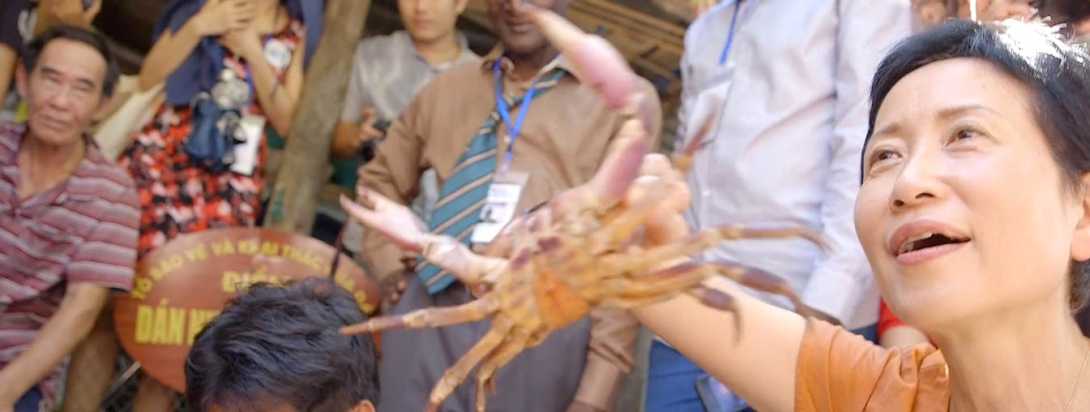
Conserving the global commons can mean grappling with complex issues, studying the science underlying them, and making far-reaching commitments. But it can also involve measuring crabs in a hot village square.
At the end of June, delegates to the Sixth Global Environment Facility (GEF) Assembly in Da Nang, Viet Nam, did both. After two days of intensive meetings, involving heads of government, ministers, and top scientists and businessmen, a group of them headed off to the nearby Cham Islands to witness conservation, literally, at ground level.
[video:https://vimeo.com/278605558]
The islands are home to a community-led initiative which has succeeded in saving their remarkable land crabs (Gecarcoidea Ialandii), a species that lives in caves in the islands' damp forests and only goes to the coast to lay its eggs in hollows in the rocks filled with seawater.
The initiative was made possible by the GEF Small Grants Programme (SGP), implemented by the United Nations Development Programme, which this year celebrates its 25th anniversary. So far it has provided over $580 million to more than 21,500 projects around the world in grants of just $50,000 or less.
Taken together, the grants - which are given directly to community-based organizations and civil society organizations - have so far supported 8.41 million hectares of protected areas, conserved 1,803 significant species, brought 900,000 hectares of land under practices that counter its degradation, and placed 32,000 hectares of marine and coastal areas under sustainable management.
Yoko Watanabe, Global Manager of the programme, says “it provides finance as well as technical expertise and really empowers local communities to be agents of change in addressing environment and livelihood issues. Small grants, but big impacts – that's what we are!”
She calls the land crab project – on the eight small Cham Islands, totaling just 15 sq km – “a very innovative initiative by the local community.”
The islands are set in a rich marine reserve – host to 277 species of coral, 270 of fish, and 97 of mollusk – but less than a decade ago the large black-backed crabs were in sharp decline, overharvested as delicacies for visiting tourists.
Back in 2009, the authorities suspended catching and selling the crabs, but without success. They continued to be caught and sold illegally. So then - in cooperation with the help of the GEF SGP and the nearby mainland city of Hoi An - the local Tan Hiep Communal Association of Farmers devised a way of managing the crabs sustainably. This set up a community group, now with 43 members, to harvest the crabs. The group meets at the end of each month to monitor and review how things are going and decide how many can be caught in the following month. There is an annual maximum catch of 10,000 crabs.
Only mature crabs can be sold – the rest must be returned to the forest – which is how the delegates came to be helping to measure them. Any measuring less than 7cm across their shells have to be released back into the forest. The bigger ones are labeled with a highly adhesive sticker and go to the nearby market.
Studies at Vietnamese universities have shown that these community-imposed restrictions are conserving three-quarters of the islands' crabs each year, with the result that their population is now growing. Prices have more than quadrupled since the scheme was introduced, greatly increasing the harvester's incomes, and they, in turn, pay a fee of some US$1.75 per kilogram of crab to fund it.
The land crab is seen as a “bridge” species that connects the islands' forests with the ocean. It is a biological indicator of the health of both habitats, and its recovery has improved them. This, in turn, has increased ecotourism - and thus incomes and the islands' economy, since almost a third of the islands' households are directly involved in it
“On the one hand the land crabs are protected, on the other hand, local people still have livelihoods,” says Chu Manh Trinh, the representative of the marine reserve who guided the delegates round the project.
The GEF SGP project ended three years ago, but the sustainable management scheme has continued to flourish and has gained a national and international reputation, as the delegates' visit testified.
Stefan Schwager, who represents the Swiss government on the GEF Council said it was “refreshing” for Council members “to go to places where you see what's happening on the ground, meet and hear the people, and see it is beneficial for the environment and also at the same time for the local population”.


